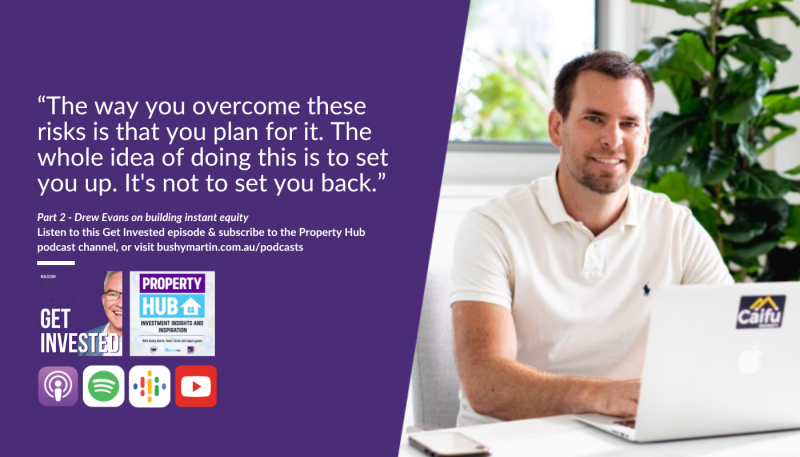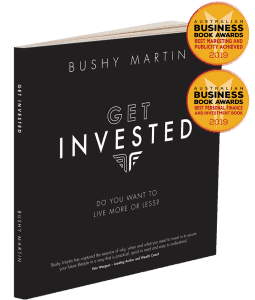You can overcome major construction and property development risks by controlling the key elements of cost, time delivery and quality, says Drew Evans.
Drew is an active property investor with a portfolio valued at $25 million, who ‘build instant equity’ through small developments.
While renovating, subdividing and developing properties can come with major risks, he advised these can be easily managed with the right measures and preparation.
He joined KnowHow’s Bushy Martin on Property Hub’s Get Invested podcast to discuss the risk mitigation steps across different stages of an investor’s property development journey.
Risk mitigation: Determine your tolerance
Investors and small property developers first need to categorise the potential risks into what they’re comfortable with.
“The risks are you have a cost blowout, a time blowout, the builder goes bust, or the interest rates go up. Again, all of these things are outside of your control to some extent. But the way that we protect it is we have fixed price contracts, we have full liquidated damages, we do thorough research on the builders that we use. In terms of interest rates, you’ve got an interest bill that’s going out, but you don’t have any rent that’s coming back in return. But the way that you overcome that is you plan for it. This isn’t rocket science, you know what’s going to happen, so plan for it,” Drew said.
“And if you can’t afford it now, then that’s okay. Either save up more money or get another structure in place to allow you to do it so that you’re not losing sleep overnight, and it’s not causing too much stress and anxiety. The whole idea of doing this is to set you up. It’s not to set you back.”
Risk mitigation: Don’t over or under capitalise
Drew revealed there are two ways property developers can lose money – over capitalising and under capitalising.
“Number one is you can overcapitalise on a project, which I’m guilty of. I like nice things, especially when it comes to my own home. But nice things don’t necessarily give you a dollar return on your capital,” he said.
“And number two is you can undercapitalise. This is one of my favourite sayings when it comes to developing – cheap is not affordable, and cheap is cheap for a reason. If you build a cheap product, you should expect to get a cheap result. Now that’s very different towards building towards a demographic and towards building on a cost. Very different. But unfortunately, in developing, you see far too many people cut corners and those corners get reflected in the end results.”
Risk mitigation: Focus on the numbers
In order to improve property investment outcomes in the development space, investors need to clearly identify what the numbers are going to be, undergo due diligence, and walk away from a deal if it doesn’t seem like the perfect fit.
“For me, it’s all about the numbers. It’s about the finance, it’s about the numbers, and then it’s about the result. Always in developing, you need to protect your capital at all costs. So for me, it’s capital protection first, profit creation secondary. Nothing is stopping you from having a gun to your head pulling the trigger on an acquisition. And if it is, it’s probably the wrong acquisition right now. Don’t get caught up in all the hype,” Drew explained.
“Now sometimes there might be occasions where you need to make a decision quickly. But to get in that position, to make a decision quickly, you’ve done your research, you’ve done your due diligence, and you understand how things work. Because, let’s face it, deals that good, they don’t sit on your typical websites like reaestate.com or domain or get advertised everywhere. They get snapped up by people like me well and truly beforehand.
“So again, when it comes to developing, think twice, cut once, see the numbers for what they are. Don’t massage them to what you want them to be, and that’s a mistake we see all too common. You know, I’ll pay this for the land, and the builders told me this is how much it’s going to cost to construct, and when it gets finished, I’ve spoken to this agent and they said it’s going to be x amount. And it’s like, wrong, wrong, wrong, wrong, wrong. And the only sucker that’s going to pick up the tab is you as the developer or the investor.”
Risk mitigation: Enter the right marketplace
Drew recommended developing in undersupplied marketplaces, while also considering the ‘niche micro drivers’ to maximise success.
“The reality is we only go into marketplaces that are, in our opinion, undersupplied. And so you need to have a vacancy rate that’s at a healthy level, so that there’s going to be huge demand, not only for renters, but also for potential resellers as well. Some marketplaces, a lot of builders actually won’t go in development,” he said.
“Again this comes back to macro economics 101. PIE – what’s the population doing? What’s the infrastructure, both public and private? Where all the jobs? Property investing should be as easy as pie – population, infrastructure and employment. But again, anybody can sit on the internet and find that information. And it’s really not that hard. You then look at your micro drivers. These are things like your demand versus supply, days on market, yield variation, vacancy rate, comparable sales. You can sit on the internet long enough and find this stuff out. It’s time consuming, but it’s not hard.
“Where the gold is, in my opinion, is these niche drivers, and these are what really separates the successful investors from those who potentially might not be as successful. Which is all about, how do you get the highest and best use of your land? What is the best design for the demographic? What’s the street frontage? What are the easements? What are the setbacks? How do you maximise the building pad? So all these little bits and pieces, we always go and get independent town planning advice letters. We know it fits the local environment plan, it fits the development control plan, it fits all the covenants that we’re developing. So we’re not pushing the friendship with local councils. So they’re all the things we look at.”
Risk mitigation: Consider before selling
Drew advised developers not to sell a property unless one of two reasons are relevant.
“Obviously you want to invest in areas that have good fundamentals for long term growth. It’s not about getting into property and getting out of property. You and I both know that that can get very expensive. You’ve got to pay stamp duty, legal fees, insurances, you got to pay a whole bunch of different things. And when it comes to selling, you got to pay capital gains tax, got to pay an agent etc. So the on costs and off costs with real estate becomes expensive,” he said.
“And so my advice is to never, ever sell unless one of two things are preventing you from moving forward. Number one is your current portfolio is preventing you from growing, so something has to give. Number two is the opportunity cost of holding a property outweighs the opportunity cost of selling it. I had a project that I didn’t need to sell, but I wanted to. So I sold it, and while I paid off my dream house, if I had held that property it’d be worth one million more today. So those are the only two ways that I would ever consider selling, unless it is your specific strategy to buy, develop, sell, buy, develop, sell and you treat it as a trading entity.”
Risk mitigation step: Find the right help
Drew shared the questions that investors should ask when assembling a team of experts and independent professionals.
“I think a proven track record is the obvious one. So, how long have you been in business for? What are some of the results you’ve typically gotten? Don’t tell us about your best performing opportunities, tell us about your worst ones. You can tell a lot by someone if they’re going to be upfront and honest to you right at the very beginning. What team do you have behind you? Because again, unfortunately, there’s a lot of people that pay X amount of money to become a buyer’s agent, but what have they personally done?” he said.
“Also, have you physically invested in the projects that you’re recommending to your clients? The last ten projects that I’ve done personally, my clients have invested right next door to me. So it’s not like I’m telling them to do one thing with their money, and then I’ll go in a completely opposite direction with mine. That’s not like I’m telling you how pushy you’re going to do one thing with your money, and then I’ll go in a completely opposite direction with mine.”
Listen to the full interview here.
Want to Know How you can build wealth and optimise your property finance with the help of leading, qualified experts? Check us out and talk to the team, now.




